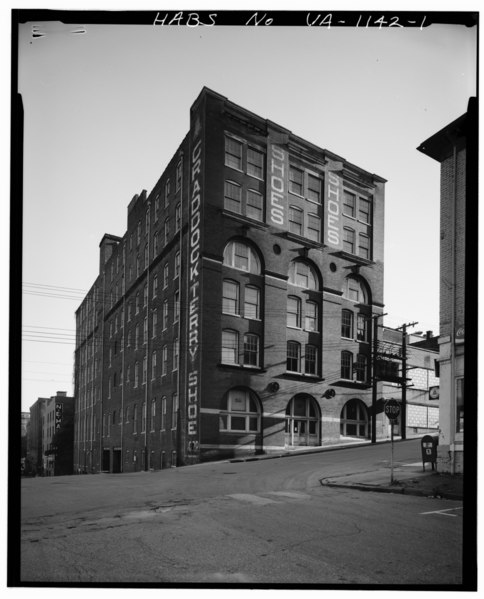I've had some city directories for my great grandmother Callie Fenity Keats for a while. I went looking for them because I was trying to trace her migration from Pittyslvania County, Virginia up to Baltimore, Maryland where she spent the rest of her life. From 1936 to 1940 I have her documented going back and forth between Lynchburg and Roanoke, Virginia.
Once I had the dates and places, I didn't give the directories any more thought. But there is more to find from U.S. city directories, especially in terms of information about jobs.
 |
| U.S. City Directories, 1821-1989, digital images, Ancestry.com (http://search.ancestry.com/search/db.aspx?dbid=2469&enc=1), Callie M Finety, citing Hill’s Lynchburg (Campbell County, VA.) Directory 1936 (Richmond: Hill Directory Co., Inc., Publishers, 1936) p. 173. |
An important element of these city directories is seeing past the abbreviations. The line of interest to me here is "Finety Callie M stitcher Craddock-Terry Co r1814 Park av."
What can we glean from that one line? Well, we know that the directory is for the city of Lynchburg, and everything after the letter "r" is to delineate a residence or a room, perhaps to suggest a rental. Note the distinction of "h" which is to represent householder, or we would say homeowner.
So we have an address for Callie M Fenity (note the spelling variation of her maiden name) while she was living in Lynchburg.We see that she is renting what was probably a room at 1814 Park Avenue.
The "emp" means employment. In this case, her job position is given first, then the place of her employment. She was a stitcher at Craddock-Terry Company. Through cross referencing with the other directories and a little bit of Google searching, I discovered that Craddock-Terry was a very large shoe company.
 |
| Image available on Wikimedia Commons |
How large? Try the first shoe factory south of the Mason Dixon line, and the fifth largest producer of shoes in the world in its time. Their factory has since gone on to become one of the premier historic hotels in the South, the Craddock-Terry Hotel. But according to their own description, they once produced everything "from baby shoes to combat boots." The motif of shoes still plays a prominent role in the upscale hotel design and experience. But no doubt the stark contrast would be an incredible stretch to the imagination of someone like my great grandmother if she could see it now.
How many long hours did she spend in that factory? What were her working conditions like? I see the statistic that at one time they produced 2,500 pairs of ladies shoes a day. In their prime they produced 100,000 pairs of shoes a day. But how does that translate into the life of a young woman trying to survive during the Great Depression?
Enormous success is always built on the backs of hundreds of seemingly nameless people. Only now, at least to our family, one of those women of the Great Depression is no longer nameless. Her name is Callie May Fenity Keats.
And if I'm lucky, some record of hers may have survived in the massive haul of Craddock-Terry Shoe Company records saved by the Virginia Historical Society. Here's to hoping!
Until then, the directories give us an indication of how long she worked there. She appears as an employee to the factory again in 1937, by which point she has married Giles Blanton Keats and has taken his surname. But notice that her address has changed...
 |
| U.S. City Directories, 1821-1989, digital images, Ancestry.com (http://search.ancestry.com/search/db.aspx?dbid=2469&enc=1), Callie R Keats, citing Hill’s Lynchburg (Campbell County, VA.) Directory 1937 (Richmond: Hill Directory Co., Inc., Publishers, 1937) p. 251. |
And changes again in 1940...
 |
| U.S. City Directories, 1821-1989, digital images, Ancestry.com (http://search.ancestry.com/search/db.aspx?dbid=2469&enc=1), Callie F Keats, citing Hill’s Lynchburg (Campbell County, VA.) Directory 1940 (Richmond: Hill Directory Co., Inc., Publishers, 1940) p. 243. |
But where was she the from 1938-1939? And even more interestingly, where is her husband? She was married on Christmas Eve in December of 1936. Why doesn't her husband appear with her in some of these directories?
 |
| U.S. City Directories, 1821-1989, digital images, Ancestry.com (http://search.ancestry.com/search/db.aspx?dbid=2469&enc=1), Callie Keith, citing Hill’s Roanoke (Roanoke County, VA.) Directory 1938 Including Salem and Vinton (Richmond: Hill Directory Co., Inc., Publishers, 1938) p. 808. |
Apparently he's in Roanoke--the place they will both eventually end up and give birth to their first daughter. But for now they appear to be separated from each other.
They likely lived apart in order to maintain their jobs, Giles living in Roanoke and Callie living in Lynchburg. Given that the Great Depression was still in full swing during this time period, this actually isn't that unlikely of a scenario.
 |
| U.S. City Directories, 1821-1989, digital images, Ancestry.com (http://search.ancestry.com/search/db.aspx?dbid=2469&enc=1), Callie M Keats, citing Hill’s Roanoke (Roanoke County, VA.) Directory 1939 Including Salem and Vinton (Richmond: Hill Directory Co., Inc., Publishers, 1939) p. 288. |
Because the economy did not fully recover from the Depression until 1939 with the beginning of World War II, no one turned their nose up at a job when they found one. Making sacrifices for a paycheck was the hallmark of that generation. If it meant dividing the family to make ends meat, I'm sure Giles and Callie were not the only ones to make that sacrifice.
